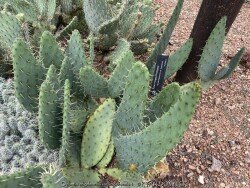
Plant Min Zone: 6b
Plant Max Zone: 10b
Sunlight: All Day Full Sun, Full Sun, Part Sun
Water / Rainfall: Very Low, Low
Soil Quality: Poor, Average
Bloom Season: Early Summer, Summer
Flower Color: Yellow
Berry / Fruit Color: Maroon
Spring Foliage Color: Green
Summer Foliage Color: Green
Fall Foliage Color: Green
Evergreen Foliage: Yes
Winter Interest: Yes
Scented Flowers: No
Drought Tolerance: High
Wet-Feet Tolerance: Low
Humidity Tolerance: Low
Wind Tolerance: High
Poor Soil Tolerance: Sandy Soils, Rocky Soils, Alkaline Soils (high PH)
Height: 1.5' - 3'
Width: 2' - 3'
Growth Rate: Slow
Service Life: Long: 5-10 years
Maintenance Need: Low
Spreading Potential: Extremely Low
Yearly Trimming Tips: Yuccas and Cacti Need No Trimming Except to Remove the Dead Flower Stalk.
Plant Grouping Size: Specimen Planting of 1-3
Best Side of House: South Exposure, West Exposure
Extreme Planting Locations: Survives Under Roof Overhang, Survives Severe Drought, Tolerates Extreme Heat, Resistant to Rabbits, Crevice Gardens
Ornamental Features: Multiple Seasons of Interest, Exceptional / Colorful Foliage
Special Landscape Uses: None
Possible Pest Problems: Root Rot Disease, Mealy Bugs, Aphids
Plant Limitations: May get Occasional Winter-kill, Environmental Stress / Decline, Needs Excellent Drainage, Has Thorns
Shippable in 2026: YES
The yellow flowers, maroon long lasting fruits, and upright growth habit of this cactus (Opuntia engelmannii var. lindheimeri) create a unique addition to the desert garden. The pads are sparsely spined, light green, and hardy to about -5 degrees F. Native to arid soils in Texas and Oklahoma, this cactus has a place as one of the few upright cacti that can handle extreme cold. In fact, I have seen this species growing a in Lawrence, KS in desert gardens along a south wall of a house. With well drained soils and proper micro-climate, this cactus can handle our extreme cold and excess rainfall of Eastern Kansas.